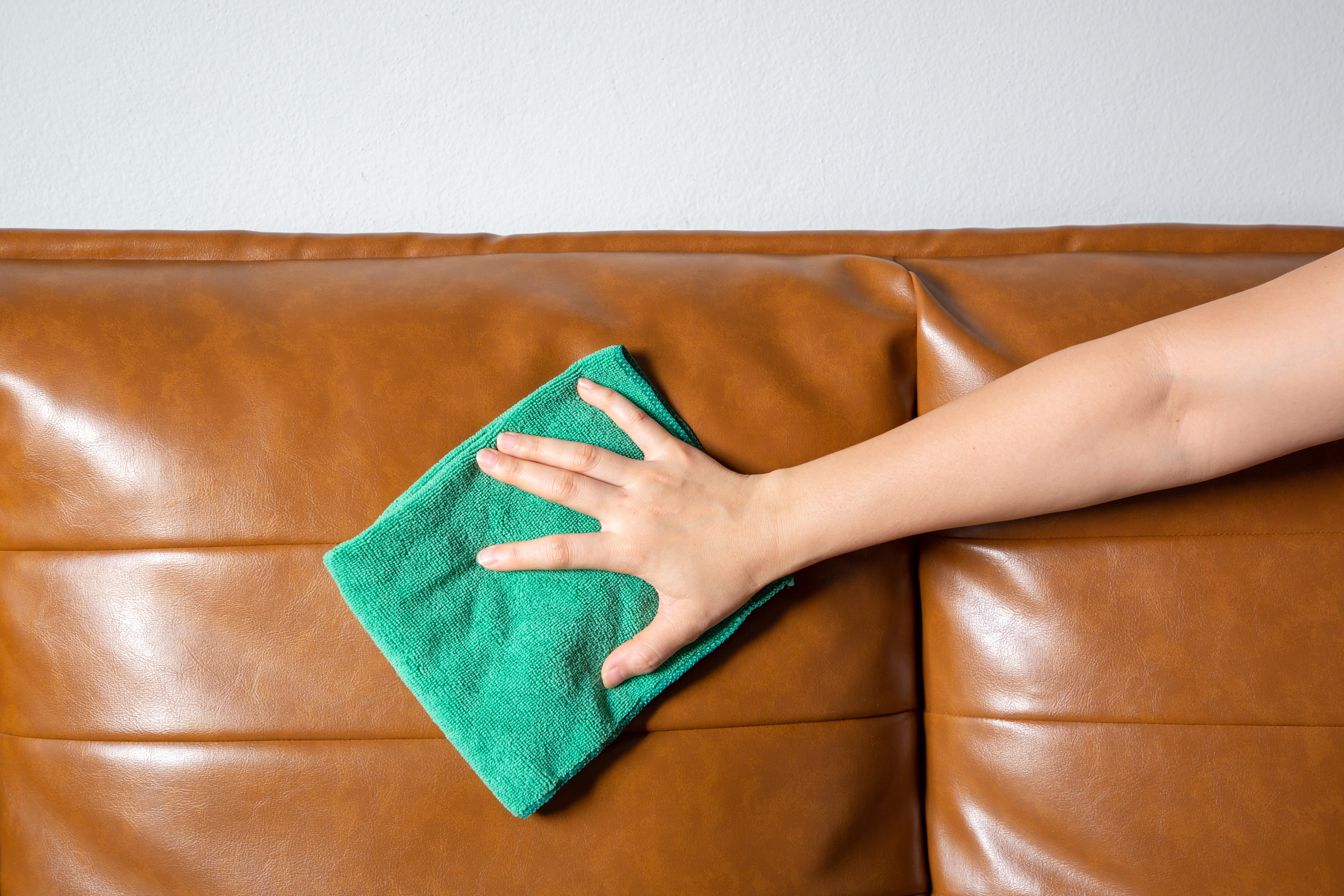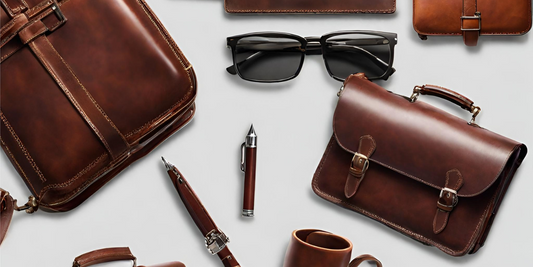Let’s delve into the world of vegan leather.
It’s considered an alternative to traditional leather, and it’s very much gaining popularity.
But is it all it's cracked up to be?
In this article, we uncover the truth behind its materials, durability, and environmental impact.
What is Vegan Leather?
Vegan leathers (sometimes called faux leather or synthetic leather) are leather alternatives that do not use animal products.
Vegan leathers will usually be made using plastic or plant-based materials, and are used mostly by furniture and fashion brands, particularly for items like clothing and chairs.

What is Vegan Leather Made Of?
There are different types of vegan leather and each are made from different materials.
Each of them is able to be moulded into a semi-similar texture we’re used to seeing in animal leather, with the creases and detailing to give it that leather effect.
The two most common are PU leather and PVC leather, but there are some alternative options made from natural materials like cork or even fruits such as pineapple leaves.
1. PU Leather (or pleather)
PU leather (polyurethane) is considered to be vegan. This leather is made with a thermoplastic polymer and is used for things like leather jackets, furniture, handbags and shoes.
There is a popular and “less pure” variant of PU that uses parts of cowhide, so it’s important to check the labels if you’re looking for completely vegan products.
PU leather is typically easy to clean but will wear down much more quickly than real leather.
The polyurethane used is technically a type of plastic. Therefore it is produced in a factory that is likely to burn fossil fuels. As a result, its sustainability can be called into question.
Due to its coating and artificial nature, PU leather also isn’t biodegradable, so if you’re looking for environmentally friendly options, you’d likely be better with long-lasting real leather than this synthetic leather alternative.

2. PVC Leather
PVC (polyvinyl chloride) leather is typically made in the same way as polyurethane leather, with a plastic coating on the fabric that is then textured for a leather effect.
PVC is a popular plastic material, and this means that PVC vegan leather is often very affordable.
You may sacrifice product quality due to its shiny, sometimes plastic-like appearance, but it’s definitely an affordable option.
3. Microfiber Leather
Microfiber leather is made from ultra-fine fibers, typically composed of polyester and polyurethane.
These fibers are combined to create a material that closely resembles the look and feel of genuine leather.
Microfiber leather is often used in high-quality vegan leather products and is known for its durability and soft texture.
Again it has similar durability characteristics to PU and PVC leathers in that it will not last as long as real leather.
4. Pinatex
Pinatex is a sustainable alternative to traditional leather made from pineapple leaves.
The fibers are extracted from pineapple leaves, a by-product of the pineapple industry, and then processed into a durable and versatile material.
Pinatex is gaining popularity for its eco-friendly credentials and unique texture.
While Pinatex will not have the same durability as genuine leather, it is truly sustainable as it’s made from biodegradable natural, sustainable materials.

5. Cork Leather
Cork leather, also known as cork fabric or cork skin, is made from the bark of the cork oak tree.
The bark is harvested without harming the tree, making cork leather a good option for sustainable fashion.
It has a distinctive texture that some do like, but it is quite different to how real leather feels. It is often used in accessories like wallets and bags.

6. Mushroom Leather
Mushroom leather, also called mycelium leather, is a biodegradable material made from the root structure of mushrooms.
It's an innovative and eco-friendly alternative to traditional leather, with a texture similar to suede.

How is Vegan Leather Made?
Vegan leather is crafted using various processes designed to mimic the look and feel of traditional animal leather.
While the exact methods can vary depending on the type of vegan leather being produced, here's a general overview of the manufacturing process:
1. Base Material Selection
The first step in making vegan leather is choosing a suitable base material.
Common base materials include polyester, nylon, cotton, or other synthetic fibers.
These materials serve as the foundation for vegan leather and provide stability and structure.
2. Coating or Laminating
Once the base material is selected, it is typically coated or laminated with a layer of polyurethane (PU) or polyvinyl chloride (PVC).
This coating gives the material its leather-like appearance and texture.
In some cases, additional layers or treatments may be applied to enhance durability, water resistance, or other properties.
Alternative Methods
In addition to traditional coating methods, innovative techniques and materials are being developed to create vegan leather.
For example, some companies are experimenting with plant-based materials like pineapple leaves (Pinatex), mushrooms (mycelium leather), or cork bark (cork leather) to produce sustainable and eco-friendly alternatives to traditional leather.
3. Embossing and Texturing
To further mimic the look and feel of genuine leather, the coated material may undergo embossing and texturing processes.
This involves pressing the material with patterns or textures to create a realistic leather-like surface.
Embossing can range from simple grain patterns to intricate designs, depending on the desired aesthetic.
Is Vegan Leather Real Leather?
Real leather is not vegan and vegan leather is not real leather.
Real leather created from an animal hide. Real leather is a durable and flexible material created by a vegetable or chromium tanning process.
Synthetic leather alternatives are made mostly from plastics or natural materials and therefore are not real leather.
These materials are often not designed to be long lasting in the same way that real leather is.

How to Clean Vegan Leather
Most vegan leather, due to its high plastic content, is fairly easy to clean.
Unfortunately, it is often more prone to damage, so it’s important that you clean and maintain it properly.
To remove stains, dirt, or dust, you should be able to wipe down vegan leather with a soft damp cloth.
If dirt is dried, warm water should help you to clean vegan leather goods without damaging them.
If your vegan leather is more textured, a soft brush should help to clean grooves and details whilst preserving the product.
For tough stains, try adding some soap to your warm water, or a tiny amount of natural oil in moderation.
Vegan leather is much more fragile than real leather.
We advise against using abrasive materials like hard or metal brushes. Strong cleaning solutions will also likely damage your vegan leather product.

The Pros & Cons of Vegan Leather
The Pros of Vegan Leather
For those motivated by animal ethics rather than environmental impact and product quality, vegan leather does have its perks.
For many, the lack of animal hide and cruelty free considerations are the biggest selling points for vegan leather.
It’s an increasingly realistic alternative to traditional leather products that don’t rely on animal hide.
One thing to be aware of is that not all faux leathers are vegan, and multiple types of fake leather can still include parts of animal hide.
Vegan leather is typically a cheaper option too.
As it’s mostly made from cheap-to-produce plastics, it can be made for use with furniture, clothing and products like bags fairly easily.
Of course, it will need to be replaced far more often than real leather, but it’s price point might make that possible, with the down side of increased waste.
The Cons of Vegan Leather
Vegan leathers generally are not as high quality.
Although they are textured to mimic genuine leather, most people are able to easily spot genuine products.
For products like chairs and bags, faux leathers are recognizable from their plastic-like appearance and shine.
This can mean they’re more susceptible to damage and can be much quicker to suffer from wear than real leather.
The actual properties of vegan leather can also be an issue.
Some faux leathers have an unpleasant plastic or can even contain a toxic chemical smell that takes time to fade.
The material itself is non-breathable which can make it more susceptible to cracking and damage.
There are also important questions about just how sustainable vegan leathers are.
Not only are most plastic-based leathers non-biodegradable, but they also encourage a cycle of repeat purchase as the (often) lack of quality results in quick wear.
A real leather product will much more likely stand the tests of time and day-to-day damage, and, if properly maintained, not require replacement.
Durability of Vegan Leather
When it comes to durability and longevity, vegan leather may not always measure up to the real thing:
1. Susceptible to Wear
Vegan leather, especially those made from synthetic materials like polyurethane (PU) or polyvinyl chloride (PVC), tends to be less durable than genuine leather.
It can be prone to cracking, peeling, or tearing with regular use, particularly in high-stress areas like seams or corners.
2. Resistance to Aging
While real leather develops a rich patina and becomes more supple and attractive over time, vegan leather lacks this natural aging process.
Instead, it may deteriorate more quickly, losing its color or texture and diminishing in appearance with prolonged use.
3. Maintenance Challenges
Vegan leather products may require more frequent maintenance and care to preserve their appearance and extend their lifespan.
Without proper care, they can become stiff, discolored, or damaged, reducing their overall durability.
4. Environmental Impact of Replacement
Because vegan leather products may need to be replaced more frequently due to wear and tear, this can contribute to increased consumption and environmental impact.
The production and disposal of multiple vegan leather items over time can generate more waste and resource usage compared to a single, long-lasting real leather product.
5. Investment Considerations
While vegan leather products are often marketed as more affordable than genuine leather, their shorter lifespan may ultimately make them a less cost-effective investment in the long run.
Real leather goods, with proper care, can last for decades or even generations, making them a durable and sustainable choice for those seeking longevity and value.

The Environmental Impact of Vegan Leather
Vegan leather is often marketed as a more eco-friendly alternative to traditional leather. But its environmental impact has both positives and negatives.
1. No Animal Hides
The most obvious impact is the use of no animal skins.
Vegan leather does not involve the use of animal hides. Therefore, you can be fairly certain that vegan leather is cruelty-free.
It can also reduce reliance on the meat industry. Most shoppers will be aware of the demands the meat industry places on natural environments such as the rainforests in Brazil.
2. Resource Use
The production of vegan leather typically involves the use of synthetic materials such as polyurethane (PU) or polyvinyl chloride (PVC), which are derived from fossil fuels.
The manufacturing process requires significant energy and resources, including water, chemicals, and machinery, contributing to carbon emissions and environmental pollution.
3. Chemical Pollution
The production of synthetic materials like PU and PVC involves the use of toxic chemicals, including solvents, plasticizers, and dyes.
These chemicals can have harmful effects on human health and the environment, especially when released into waterways or soil during manufacturing or disposal.
4. Limited Biodegradability
Some vegan leather alternatives, such as those made from plant-based materials like pineapple leaves or cork, may be biodegradable
However, most synthetic vegan leathers are not biodegradable.
This means that they can persist in the environment for long periods, contributing to landfill waste and microplastic pollution.
5. Shorter Lifespan
Vegan leather products often have a shorter lifespan compared to genuine leather goods.
They may be more prone to wear and tear, cracking, or peeling over time, leading to faster replacement and increased consumption.
This can result in higher overall environmental impact due to the need for more frequent manufacturing and disposal of vegan leather products.
6. Lack of Regulation
Unlike traditional leather, which is subject to strict regulations and standards for animal welfare and environmental sustainability, the production of vegan leather is not as closely regulated.
This lack of access can lead to inconsistent practices and varying levels of environmental responsibility among manufacturers.

Vegan Leather vs. Real Leather
It might not come as a surprise that we’re big fans of real leather.
Yes, real leather results in a high-quality final product, but there are many other features that make it hard to ignore the appeal of real leather.
Real leather is a unique material in that age doesn’t deteriorate it at anywhere near the same rate as most other fabrics.
Real leather products, when well cared for, can last for decades.
Our real leather bags are designed to last for years and provide reassurance that your belongings are protected whilst also looking stylish.
Most real leather products will even look better (and become more comfortable) with age, which can’t be said for vegan and faux leathers.
The strong and durable qualities of real leather make it desirable for those looking for quality products.
Remember, leathers have historically been used for things like armour and boots - that’s how durable these products can be!

Why We Recommend Real Leather for Bags
While we understand the appeal of vegan leathers, we always recommend full grain leather bags and top grain leather bags.
This comes down to two things, quality and durability.
A bag has to have more substance than just fashion.
Real leather bags are able to withstand much more day-to-day use than their vegan leather alternatives.
Not only will your full grain leather bag look great, but its longevity will also make it a much more sustainable purchase than a cheaper, vegan leather alternative that will need to be regularly replaced.
If you’d like to take a look at our real leather goods, you can see our messengers, briefcases, duffles and backpacks on this website. We now offer free shipping, so checkout with total peace of mind.

FAQ’s
1. Is vegan leather as durable as real leather?
While some vegan leather products claim to be durable, they often don't last as long as real leather.
Real leather tends to be stronger and more resistant to wear and tear over time.
2. What are the environmental impacts of vegan leather?
Vegan leather is usually made from synthetic materials like polyurethane (PU) or polyvinyl chloride (PVC), which produce greenhouse gases and can harm the environment during production and disposal.Real leather, if produced in responsible tanneries in countries like Italy, Mexico and India, might have a lower environmental impact.
3. Can vegan leather be repaired like real leather?
Repairing vegan leather can be tricky and may not be as effective as fixing real leather.
Real leather can often be repaired and restored to its original condition, making it a more sustainable option in the long run.
4. Is vegan leather more affordable than real leather?
Vegan leather is usually marketed as a cheaper alternative to real leather.
However, because it tends to wear out faster, you may end up spending more money in the long term by replacing vegan leather products more frequently.
5. Are there any vegan leather alternatives that are more sustainable?
Some plant-based leathers, like those made from natural materials such as pineapple leaves, apple peels or cork, are more sustainable than synthetic options like PU or PVC.
However, these alternatives may still have limitations in terms of durability and performance compared to real leather.
6. Does vegan leather look and feel like real leather?
While vegan leather can mimic the look and feel of real leather to some extent, it often lacks the natural texture and richness of genuine leather.
Real leather develops a unique patina over time, while vegan leather may deteriorate and lose its appearance with use.
7. Are there any ethical concerns with vegan leather?
While vegan leather is cruelty-free and doesn't involve the use of animal hides, there are still ethical considerations to take into account.
Some synthetic materials used in vegan leather production may have negative environmental and social impacts, and the lack of regulation in the industry can lead to inconsistent practices.















